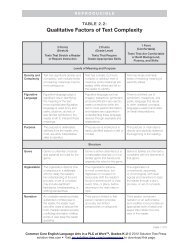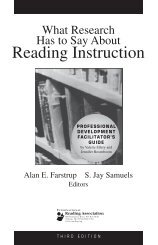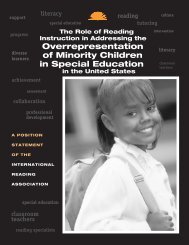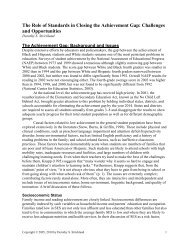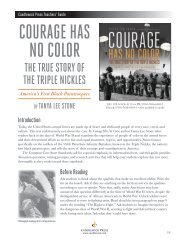Global Education Digest 2012 - International Reading Association
Global Education Digest 2012 - International Reading Association
Global Education Digest 2012 - International Reading Association
Create successful ePaper yourself
Turn your PDF publications into a flip-book with our unique Google optimized e-Paper software.
SECTION 5 / The costs of school failure<br />
FIGURE 24<br />
How many years are spent repeating grades in primary and lower secondary education?<br />
School life expectancy with and without repetition for countries exceeding a population of<br />
1 million with highest number of school years due to repetition, 2010 or most recent year available<br />
Years spent repeating grades<br />
in primary education<br />
Years spent repeating grades<br />
in lower secondary education<br />
Years spent in primary and lower<br />
secondary education excluding repetition<br />
Uruguay<br />
Laos<br />
Uganda<br />
Angola<br />
Tunisia<br />
Morocco<br />
Guinea<br />
Rwanda<br />
Timor-Leste<br />
Algeria<br />
Cameroon<br />
Sierra Leone<br />
C. African Rep.<br />
Swaziland<br />
Chad<br />
Lesotho<br />
Malawi<br />
Madagascar<br />
Togo<br />
Burundi<br />
4<br />
3 2 1<br />
0 1 2 3 4 5 6 7 8 9 10<br />
School life expectancy (years)<br />
Note:<br />
Countries are ordered by the total number of years spent repeating grades in primary and lower secondary education.<br />
Source: UNESCO Institute for Statistics database.<br />
learning achievement because of the range of factors<br />
involved. Nevertheless, addressing the persistent and<br />
low quality of learning outcomes is a serious concern<br />
regardless of efficiency considerations and should<br />
be a key ingredient in any policy intervention (Cuadra<br />
and Fredriksen, 1992).<br />
It is possible to identify interventions to lower the<br />
risks of grade repetition, early school leaving and low<br />
levels of learning achievement at different stages in<br />
a student’s educational experience. Some of these<br />
interventions include:<br />
••<br />
ensuring transition (in intermediate stages if<br />
necessary) to reduce or target the practice of<br />
repetition;<br />
••<br />
focusing on early intervention – ensuring wider<br />
access to pre-primary programmes to facilitate<br />
school readiness;<br />
••<br />
reducing the over-age population by addressing<br />
the direct causes of late entry;<br />
••<br />
investing resources in education quality in early<br />
grades to ensure successful early learning; and<br />
••<br />
developing a range of compensatory opportunities<br />
for skills formation for early school leavers and<br />
young people.<br />
An obvious starting point for policy formulation is<br />
establishing whether grade repetition or automatic<br />
promotion is better for student learning. Results<br />
from international learning assessments like LLECE,<br />
PASEC and SACMEQ show that low student<br />
56








